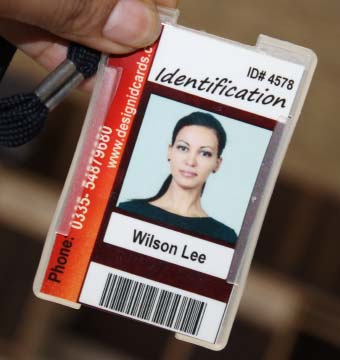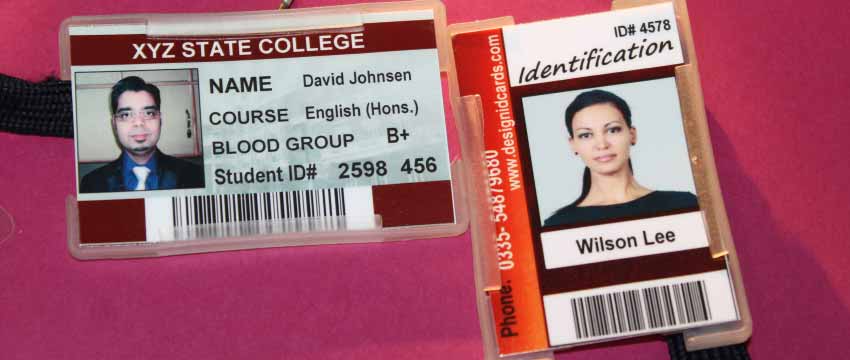Importance of Student ID Badges
Student ID badges serve several important purposes:

-
Identification and Access Control:
Student ID badges help identify individuals and ensure that only authorized students and staff members have access to school premises. By visually verifying the ID badge, school staff can quickly determine if someone belongs on campus or if they are a potential security risk. This helps maintain a safe and secure learning environment.
-
Attendance Tracking:
ID badges often include barcodes, magnetic strips, or embedded RFID chips that can be scanned or swiped to record attendance. This automated system saves time and reduces errors compared to manual attendance tracking methods. It also helps schools monitor student attendance patterns and identify students who may be consistently absent or tardy.
-
Library and Resource Center Usage:
Many educational institutions have libraries or resource centers where students can borrow books, access computers, or utilize other resources. Student ID badges are often required to check out materials or gain access to these facilities, ensuring that only authorized students can utilize these resources.
-
Cashless Payment and Purchases:
Some student ID badges incorporate payment functionalities, allowing students to load money onto their cards and use them for various purposes within the school premises. This system is particularly useful in cafeterias or vending machines, where students can make purchases without carrying cash.
-
Public Transportation and Student Discounts:
In certain cases, student ID badges can serve as a form of identification for students using public transportation systems. These badges may also enable students to access discounted fares or special offers from partnering businesses, promoting student engagement and participation in the local community.
-
Enhanced Safety and Emergency Preparedness:
During emergencies or lockdown situations, student ID badges assist in quickly accounting for students and staff members. Authorities can use ID badges to verify the presence of individuals and ensure their safety during evacuation or other crisis scenarios.
-
School Services and Privileges:
Student ID badges may grant access to various school services, such as sports facilities, laboratories, or extracurricular activities. They can also provide proof of eligibility for specific privileges, such as student discounts at local businesses or admission to school events.
Elements Typically Included in a Student ID Badge Design
Designing a student ID badge involves considering various elements that ensure clarity, functionality, and adherence to the institution's branding guidelines. While the specific design elements may vary based on individual preferences and institutional requirements, the following are some typical elements found in a student ID badge design:
-
Student's Photograph:
The student's photograph is an essential element of the ID badge. It helps in visual identification and ensures that the badge belongs to the rightful owner. The photograph should be clear, well-lit, and prominently placed on the badge.
-
Student Identification Number:
A unique identification number assigned to each student is often included on the ID badge. This number serves as a reference for administrative purposes, such as attendance tracking, enrollment verification, or accessing student records.
-
Lanyard or Attachment Method:
The method of attaching the ID badge to the student's person should be considered during the design process. Common options include lanyards, badge clips, or retractable badge holders. The attachment method should be secure, comfortable, and easy to use.
-
Expiration Date:
To maintain security and prevent misuse, some ID badges include an expiration date. This date indicates the validity period of the badge and prompts students to renew their identification as needed. The expiration date should be clearly visible and easy to understand.
-
Barcode, Magnetic Strip, or RFID Chip:
Many ID badges incorporate a barcode, magnetic strip, or embedded RFID (Radio Frequency Identification) chip. These technologies enable quick and accurate scanning or swiping for various purposes, such as attendance tracking, library access, or cashless transactions. The placement of these elements should be carefully considered to ensure ease of use.
-
Design and Colors:
The overall design and color scheme of the ID badge should be visually appealing while maintaining legibility. The design should align with the institution's branding guidelines and reflect a professional image. Consideration should be given to font styles, color contrast, and the use of negative space to ensure readability and aesthetic appeal.
-
Institution's Name and Logo:
The name and logo of the educational institution should be prominently featured on the ID badge. This element helps establish the badge's authenticity and reinforces the institution's brand identity. The logo should be clear, well-positioned, and consistent with the institution's official branding guidelines.
-
Reverse Side Usage:
Some ID badges utilize the reverse side for additional information or functionality. This can include a map of the campus, emergency procedures, or guidelines for using the ID badge. Careful consideration should be given to the layout and design of the reverse side to maximize its usefulness while maintaining clarity.

-
Additional Information:
Depending on the institution's requirements, additional information may be included on the ID badge. This could include the student's grade level, major, contact information, or emergency contact details. The inclusion of such information should be carefully considered to balance functionality, privacy concerns, and the overall design aesthetic.
-
Security Features:
ID badges may include security features like holograms, UV ink, or other anti-counterfeiting measures. These elements help prevent unauthorized duplication or tampering, ensuring the integrity of the badge and the identification process.
-
Student's Name:
The student's name is usually displayed prominently on the ID badge. It helps identify the student quickly and easily. The font size and style should be legible to ensure readability from a distance.
-
Accessibility Considerations:
Designing ID badges with accessibility in mind is crucial. Elements such as font size, color contrast, and Braille information (if necessary) should be considered to ensure that individuals with visual impairments or other accessibility needs can easily identify and utilize their ID badges.
When designing student ID badges, it is essential to balance aesthetics, functionality, and security considerations. Collaboration between designers, administrators, and other stakeholders can ensure that the ID badge design meets the institution's specific needs while providing a positive identification experience for students.
Designing Principles to Consider When Creating Student ID Badge Designs
When creating student ID badge designs, several design principles should be considered to ensure clarity, functionality, and visual appeal. Here are some important design principles to keep in mind:
-
Simplicity:
Keep the design clean, simple, and uncluttered. Avoid overcrowding the badge with excessive text or graphics. Emphasize the essential elements such as the student's photograph, name, and institution's logo. A simple design ensures easy readability and quick identification.
-
Legibility:
Use legible fonts and appropriate font sizes to ensure that the information on the ID badge is easily readable from a reasonable distance. Consider the contrast between the text and the background to enhance legibility. Avoid using overly decorative or complex fonts that may hinder readability.
-
Hierarchy:
Establish a visual hierarchy to guide the viewer's attention. Important elements like the student's name or photograph should be more prominent and easily noticeable. Consider using larger font sizes or bolder typography for key information. Maintain a logical flow and organization of elements to aid quick identification.
-
Branding:
Incorporate the institution's name, logo, or other branding elements in a visually appealing manner. Adhere to the institution's branding guidelines to maintain consistency and strengthen the institution's identity. Consider using the appropriate size and placement of the logo to avoid overwhelming the badge design.
-
Balance:
Create visual balance by distributing the elements evenly throughout the badge design. Avoid overcrowding one area of the badge while leaving other areas empty. Consider the placement and size of each element to achieve a harmonious and balanced composition.
-
Consistency:
Maintain consistency in design elements and layout across different ID badges within the institution. This consistency ensures a unified and professional look. Consider establishing design templates or guidelines that can be easily replicated for future badge designs.
-
Proximity and Alignment: Group related information together to establish visual relationships and improve readability. Place elements that belong together, such as the student's name and photograph, in close proximity. Align text and graphics to create a cohesive and organized design. Consistent alignment and spacing contribute to a professional and polished appearance.
-
Color Palette: Select a color palette that aligns with the institution's branding guidelines. Consistency with the institution's colors helps reinforce the badge's authenticity and creates a sense of belonging. Ensure sufficient contrast between the text and background colors for readability. Use colors sparingly and purposefully to avoid visual overload.
-
Adaptability: Design ID badges that can accommodate different student information without compromising the overall design. Consider the flexibility to include additional details, such as grade level or major, if required. Ensure that the design allows for easy updates or changes to student information as needed.
-
User-Friendly and Practical: Consider the practicality of the ID badge design. Choose appropriate badge sizes that are easy to carry and display. Consider the durability of materials used to ensure the badge can withstand regular use. Also, take into account any specific features such as punch holes, notches, or slots to facilitate attachment methods.
-
Accessibility: Ensure that the design considers accessibility for individuals with visual impairments or other accessibility needs. Use high contrast colors, large fonts, and consider including Braille information if necessary. Create designs that can be easily identified and used by all students, regardless of their abilities.
-
Test and Iterate: Before finalizing the design, conduct usability tests or seek feedback from stakeholders, including students, administrators, and staff members. This feedback can help identify any potential issues or improvements needed in the design. Iteratively refine the design based on the feedback received to ensure the best possible outcome.
By considering these design principles, student ID badge designs can effectively convey information, enhance identification, and contribute to a professional and cohesive institutional image.